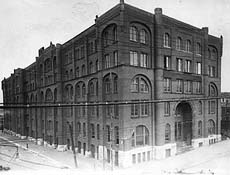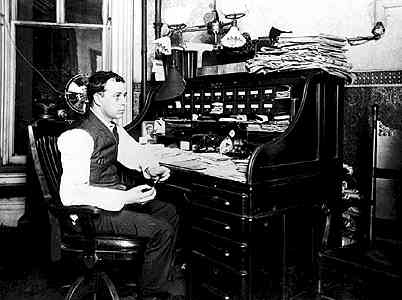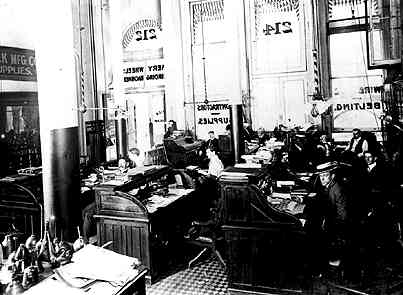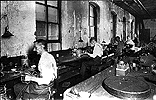|
|
A 1902 Tour of the Handlan Buck Company
At the turn of the century, railroads were a growth industry. Not
only were new lines being built and expanded, but the suppliers of railway
equipment and materials were also booming. One of these suppliers
was Handlan-Buck Manufacturing Co., makers of many types of railroad
lanterns, marker lamps, and other small equipment. In 1902, the
company took a series of photographs of its operations at its St. Louis
facilities. Copies of these photographs are rare, but some have
survived nearly a century as a remarkable record of the manufacturing
practices of the time. We present some of these photographs here,
courtesy of KL&L member Bill Kajdzik, who generously provided scans
of the photographs as well as related information.
 The
company. At the time these photos were taken, Handlan-Buck
had already been in business 46 years, tracing its origins to a company
started by Myron Buck in 1856. Alexander Handlan joined the business
in 1869 and by 1895 had bought out Buck's share. By 1902
the company name had been changed to Handlan-Buck Manufacturing Company,
evidently retaining the "Buck" name in the title for "name
brand" recognition. The company continued to be a major player
in the lantern and lamp manufacturing business from many years under
a number of name changes, all of which incorporated the Handlan name. The
company apparently stayed in business until only a few years ago, and
reportedly at least one building from this company continues to exist
in St. Louis. The
company. At the time these photos were taken, Handlan-Buck
had already been in business 46 years, tracing its origins to a company
started by Myron Buck in 1856. Alexander Handlan joined the business
in 1869 and by 1895 had bought out Buck's share. By 1902
the company name had been changed to Handlan-Buck Manufacturing Company,
evidently retaining the "Buck" name in the title for "name
brand" recognition. The company continued to be a major player
in the lantern and lamp manufacturing business from many years under
a number of name changes, all of which incorporated the Handlan name. The
company apparently stayed in business until only a few years ago, and
reportedly at least one building from this company continues to exist
in St. Louis.
The times. The photos reflect workplace and labor
practices markedly different from today. Child labor laws, occupational
safety regulations, and assembly line manufacturing practices were years,
even decades, in the future. The young age of some of the workers
in these photos is striking ( but common for that era), and the presence
of belt-driven machines, gaslights, and crowded working conditions all
suggest a rather dangerous working environment. And income? We
don't know what Handlan-Buck employees made, but a study of wages at
about the same time in New York City showed factory laborers making an
average of $489 per year. Skilled workers made more -- for
example glassworkers averaged about $700 annually -- and some of the
white-collar workers shown in the photos probably did fairly well. Still,
consider that a nice Handlan-Buck brass-top lantern can easily bring
more dollars in today's collector's market than an employee of the company
earned in a year.
The photos. To see the photos, click on the
thumbnail images as the tour progresses. Some cropping of images
has been done for web presentation and to emphasize their focus. Since
captions did not survive with the photos, we've had to make reasonable
guesses about what some of them show. Please note that download
time may be long. Now, let's begin with the front office.

|
| An
unidentified gentleman, likely an executive with the company but
probably not Mr. Handlan who would be much older at this date. The
gaslights and the rolltop desk are from another era, but the pictures
of a wife or sweetheart and the messy desk show that some things
never change. A calendar at upper right and out of view indicates
that the month is July, 1902. |

|
| Above: Likely
a sales office, judging from the well-dressed gentlemen present,
the street-level location, and the presence of sample products
laying around. Though not readily apparent, the case at the
far left contains many lanterns. The items at lower left
appear to be torches. |
To continue the tour, click on
the thumbnail images below
 |
 |
| Lantern
Production |
We hope that you've enjoyed the tour.
Footnotes: Our thanks to William M. Kajdzik for making digital
copies of the photographs available from his collection. Other
Information sources are: Barrett, Richard C., The
Illustrated Encyclopedia of Railroad Lighting: Volume I The Railroad
Lantern, Railroad Research Publications, 1994; Schlereth, Thomas
J., Victorian America: Transformations in Everyday Life, Harper Collins. |